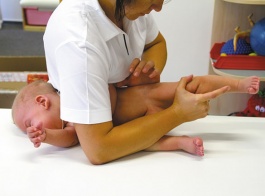Vojta Therapy
PLEASE DON'T EDIT THIS PAGE. IT IS IN PROCESS OF EDITING.
Description
[edit | edit source]
Vojta-Therapy is a dynamic neuromuscular treatment method based on the developmental kinesiology and principles of reflex locomotion. This method is supposed to treat patients with disorders of central nervous system and musculoskeletal system. It was developed by child neurologist Prof. Vaclav Vojta in the 20th century.
What is a reflex locomotion?[edit | edit source]
Reflex is an involuntary movement as a response to external stimuli. Locomotion is defined as an ability to perform a movement from one place to another. Central nervous system receives impulses by stimulating special trigger zones or reflex points that leads to the emergence of the reflex locomotion pattern.
Indication[edit | edit source]
Target group[edit | edit source]
The Vojta therapy can be applied to the patients of any age group, however it is extremely effective for young babies of age less than 6 months because most of the developmental changes take place in the early stage of a child’s life.
Indications[edit | edit source]
- Infantile postural asymmetry
- Congenital muscular torticollis (“wry neck”)
- Stroke
- Cerebral palsy
Clinical Presentation[edit | edit source]
Vojta describes 10 different zones that are available to stimulate the motor patterns of reflex locomotion. A light pressure on certain stimulus zone (muscles or bones) and resistance to the current movement is applied to cause patient's involuntary motor response and performance of certain movement patterns. [1]
The Vojta method can be divided into 2 main phases:
- Reflex creeping (lying flat with the chest down and back up)
- Reflex rolling (lying flat with the chest up and back down)
Reflex locomotion is activated from the three main positions:
- prone,
- supine,
- side lying.
Therapeutic goals[edit | edit source]
- Can control weight shift and by this activate MFD which leads to appearance of new supportive muscle functions and a change in the whole body posture.
The mechanism of intervention[edit | edit source]
The reflex locomotion elicited by Vojta therapy is associated with specific changes in cortical and subcortical brain activation when compared to the sham treatment.[2]
Evidence[edit | edit source]
- There is a lack of high level evidence for justifying the usage of the therapy.
- Taking into account the low quality (conduct score of 2/7) and the small number of participants in this study, no conclusions can be drawn on the effectiveness of Vojta therapy.This study is the first RCT to show the effects of Vojta therapy and NDT on infantile postural asymmetry. The significant effect achieved through Vojta therapy compared to NDT may be explained by its more intensive muscle activation due to relatively precisely guided movement responses to triggered reflexes.
Resources[edit | edit source]
add appropriate resources here, including text links or content demonstrating the intervention or technique
Additional facts[edit | edit source]
- Vojta therapy is an officially recognized treatment modality for infant asymmetry in Germany and paid by health insurance.[3]
References[edit | edit source]
- ↑ Gajewska, E., Huber, J., Kulczyk, A., Lipiec, J., & Sobieska, M. (2017). An attempt to explain the Vojta therapy mechanism of action using the surface polyelectromyography in healthy subjects: A pilot study. Journal of Bodywork and Movement Therapies.
- ↑ Hok, P., Hluštík, P., Kutín, M., Opavský, J., Grambal, A., Tüdös, Z., Kaňovský, P. Changes in brain activation after therapeutic stimulation using Vojta therapy: Controlled study. Clinical neurophysiology, 2014;125(5): e34.
- ↑ Jung, M. W., Landenberger, M., Jung, T., Lindenthal, T., & Philippi, H. Vojta therapy and neurodevelopmental treatment in children with infantile postural asymmetry: a randomised controlled trial. J Phys Ther Sci 2017;29(2): 301-6.







